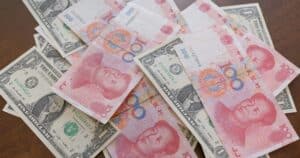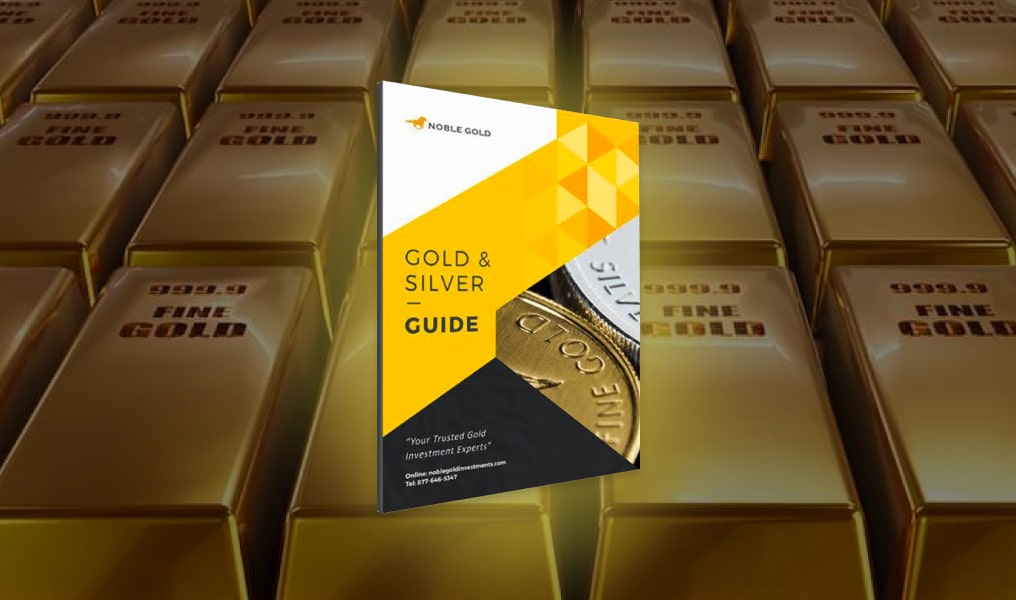Inflation is the highest it’s been within the last 50 years, and in times of economic uncertainty, many investors wonder if their stocks are a good hedge against inflation. Simply put, the answer is no.
With the stock market’s volatility, diversifying your investment portfolio with alternative assets, like gold and other precious metals, is a safe way to grow your long-term profits. If you’re interested in learning how you can safely hedge against inflation to prepare for retirement, keep reading.
What is Inflation?
Inflation is the rate at which a currency’s value decreases with the simultaneous increase in the prices of goods and services throughout the economy. It is measured by calculating the price percentage shift of goods and services over a period, typically the previous 12 months.
In July, the consumer price index (CPI) found that goods increased by 9.1% over the last 12 months. A dozen eggs that used to cost $3 would cost you $3.27 for that same dozen eggs.
While you may not flinch at a $0.27 increase in eggs, inflation has drastically impacted other areas of people’s lives. For example, in 2000, when the average household income was $40,551, the average price of a single-family home was $165,300. 22 years later, the housing market has since seen a 159% increase, placing the average home price tag at $428,700, while the average household income increased to a mere $70,181.
Simply put, inflation is the increase in prices of goods, while your paycheck won’t buy you as much as it used to.
Causes of Inflation
Inflation is caused when a government prints more money than necessary and pumps it into the economy. When there’s an over-production of cash, you won’t see these price spikes on just milk or just clothes. You’ll see it everywhere. You’ll see prices rise for need-based expenses like food, gas, and housing and want-based expenses like entertainment, clothing, and cars.
When printing cash spirals out of control, causing the prices for goods and services to inflate, the government will eventually print more money to help people keep up with these price spikes, ultimately snowballing the country into hyperinflation.
But what causes the government to print more money? Glad you asked. Three economic methods drive inflation: the Demand-Pull Effect, Cost-Push-Effect, and Built-In Inflation.
Demand-Pull Effect
The Demand-Pull Effect happens when the consumers’ demand for goods and services stretches beyond a country’s ability to meet those demands. To ease the pressure, an economy will raise prices in hopes of mitigating the demand.
However, as seen in the history of supply and demand, consumers are willing to pay more for certain things when there’s a supply shortage.
For example, during the early stages of the coronavirus pandemic, car companies canceled semiconductor chip orders from oversea suppliers. With limited materials, car production proved increasingly difficult, limiting the number of new cars available. Dealerships that did manage to receive and immediately sell these new vehicles saw the gross profit per new car increase by 61%.
Cost-Push Effect
Two different scenarios can lead to the Cost-Push Effect. It can first happen when the price of essential items rises when there isn’t a suitable alternative available. For example, we all know the oil supply significantly impacts gas prices. Since gas doesn’t have any alternatives, you can expect to pay more at the pump when oil prices go up.
The Cost-Push Effect also happens when the supply of goods and services increases while demand stays the same. For example, if beef prices rise significantly, you can expect restaurants to raise the price of burgers and steaks on their menus. Even though people demand the same amount of burgers, restaurants are forced to raise their prices to offset the higher beef price tag.
Built-in Inflation
Built-in Inflation occurs when employees demand higher wages to offset the increasing costs of living expenses. When companies give their employees a pay raise, they recuperate that financial loss by increasing the prices of their goods or services.
Built-in Inflation can turn the economy into a vicious inflation cycle. When people begin to pay more for services, they demand pay increases from their employers to maintain the same standard of living. This demand for a higher pay wage causes employers to then raise their prices, bringing it back to the beginning.
Are Stocks a Good Hedge Against Inflation?
When you purchase stocks, you’re investing in companies and are banking on their performance to secure your financial future. Although stocks make good long-term investments when the market is performing well, that’s all thrown out the window when the economy is being tortured by inflation.
The majority of the market’s Top 25 companies are non-essential businesses. When you have to spend your money on inflated essentials like $5 per gallon gas charges and a $15 rotisserie chicken, those non-essential companies that everyone told you to invest in to diversify your portfolio will most likely take a hit, and so will your stocks.
Conventional Assets That Can Hedge Against Inflation
Under any normal day, your low-risk stocks are typically good hedges against slight market fluctuations. But in times of dire economic uncertainty, even the safest stocks in your portfolio can severely underperform.
If you’re looking for government-backed investments to help hedge against inflation, these conventional assets are excellent investment vehicles, even during volatile periods when your low-risk stocks can’t survive. Some of these include:
- Treasury Inflation-Protected Securities, or TIPS, are bond investments with a principal value that rises along with commodity prices. They pay interest twice a year at a fixed rate, and because it’s applied to the adjusted principal, inflation correlates to higher interest rate payments.
- Series I Bonds are a great way to protect against inflation. With an I Bond, owners earn dividends at a fixed interest rate and an interest rate that fluctuates with inflation. These interest rates are locked in every six months, ensuring even if the interest rates drop, your savings bond will accrue interest at the rate you locked it in for at least six months.
- Ultra-Short Bond ETFs, or USBs, are active ETFs built like mutual funds but have a lower expense ratio. Although these are still stock investments, their short timeframe of 6 to 18 months limits the price volatility of the overall stock market while offering slightly higher yields.
What Are The Best Alternative Investments To Hedge Against Inflation?
If you’re concerned with the impact inflation may have on your stocks and are looking for something that works independently from conventional markets, there are alternative investment opportunities with excellent inflation hedge abilities. In times of economic turmoil, tangible investments offer a safer investment route than others.
Gold and Precious Metals
Not just a status symbol of wealth and prosperity, gold and other precious metals are also some of the best inflation hedges. They are considered excellent portfolio diversifiers because they don’t correlate with conventional assets like stocks and bonds.
Regardless of the highest highs and lowest lows, the stock market has experienced, gold’s price has steadily increased over the last 30 years, making it a safe investment whether the market is performing well or not.
The word “tangible” is often thrown around when discussing alternative investments, but why is it such an important term? In times of economic downturn, people scrounge to hold onto physical investments for fear of what could happen to their liquid assets.
There’s a sense of security surrounding tangible investments since you can physically hold them in your hand, and during desperate times, these tangible assets can act as currency or are easy to sell. If the market crashes, you can’t hand the clerk a printout receipt of your old stocks and pay for your groceries. But you could take your gold bar to the bank and exchange it for cash to pay for groceries.
But gold isn’t the only safe precious metal portfolio diversifier. Silver’s electrical conductive material makes it one of the key components used in a wide range of industrial purposes.
Because gold historically saw a higher demand than silver, silver wasn’t purposefully mined. Now that industries are utilizing its conductivity, silver’s demand is rising, but its supply hasn’t had the ability to catch up. This supply and demand gap has begun to inflate the price of silver, making it an up-and-coming investment vehicle.
The most beneficial decision you can make when investing in precious metals is purchasing them directly in an IRA. Owning gold and other precious metals is great, yes, but owning and storing them within an IRA offers tax advantages you wouldn’t otherwise see. Gold and precious metals IRAs offer holders yearly tax-deductible benefits and tax-free withdrawals from Roth IRAs once they reach retirement age.
As a buy-and-hold investment, gold and other precious metals are perfect for an IRA that’s sole purpose is to contribute to and grow long-term.
Real Estate
Real estate is one of the few investments that aren’t only a good hedge against inflation but provide owners an opportunity for continual returns on investments. Real estate either maintains or increases in value over time and spikes during inflationary periods.
At the beginning of the Covid-19 pandemic, the housing market saw a significant boom. With the need to have more space to work from home and socially distance safely, people were moving out of their downtown apartments and choosing suburban homes with bigger square footage and outdoor yard space instead.
The housing market supply was limited, and the Fed had lowered interest rates to an all-time low, resulting in offers going tens of thousands of dollars above asking price. From the start of the Covid-19 Pandemic in March 2020 to July 2021, housing prices saw a 19.3% increase. Although this was financially difficult for home buyers and renters, sellers, on the other hand, reaped the rewards of inflation-linked cash flow.
Blue Chip Art
One of the hottest art investment opportunities is blue chip art. The term “blue chip” describes works of art created by globally recognized artists like Picasso, Andy Warhol, and Leonardo da Vinci. Their legacy has secured their placement in the art market, easing buyers in knowing the piece will either hold or increase in value regardless of the economic state.
Since art doesn’t correlate with the stock market, bonds, or any other conventional investment type, it’s one of the few investment vehicles that’s not susceptible to market instabilities. Diversifying your portfolio with art is a unique investment opportunity during economic uncertainty. Art acts as a hedge against inflation in instances where stock prices drop by continuing to appreciate over time.
One of the biggest appeals to blue chip art is its one-of-a-kind nature. No matter how many people want an original work, there will only ever be one, The Water Lily by Monet or The Kiss by Klimt. Owning an authentic blue chip art piece can ensure that it will appreciate over time.
However, investing in art does have a few potential limitations. A blue-chip art investment is only profitable once it’s sold, and selling a piece of blue-chip art isn’t a simple Facebook Marketplace upload. They aren’t liquid assets, so if the time ever comes when you’re looking to sell a piece of blue-chip art, the pool of readily available buyers is small, and the process requires professionals and legal proceedings to finalize the transaction.
Hedge Against Inflation by Diversifying with a Gold-Backed IRA
If rising inflation makes you uneasy, consider investing in gold and precious metals. As a great hedge against inflation and long-term investment, you’re sure to see a value appreciation when you begin making withdrawals. Open an account with Noble Gold Investments today and begin investing for your future with our collection of IRS-approved gold coins and gold bars.
Our representatives are standing by to answer any questions you may have regarding bars, coins, or beginning your IRA journey. For more information on protecting your assets against inflation with a gold-backed IRA, call (877) 646-5347 or fill out our Contact Us form and speak with one of our agents.







